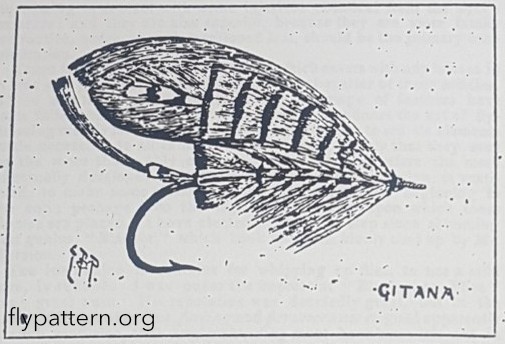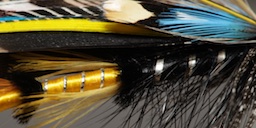From "The fishing gazette" - June14th, 1884
THE readers of the FISHING GAZETTE are kindly given to understand that the terms which I adopt for the manufacture of salmon flies are not generally known; the correspondent is evidently one of the gentlemen who is unacquainted with this "alphabet" in fly-tying, which is, or should be, the first lesson for amateurs to learn. It would be advisable also for them to prepare for a strict examination in ornithology, and for a cross-examination with flies before them, as to where this, that, or the other feather is plucked.
Until the standard colours are established, a good deal must necessarily be left to the discretion of dressers, however intimate these terms may be; but eventually the size of the materials only will be left to their judgement.
Like the rest of the world, we are liable to forget that which we chiefly desire to recall, and we are all forced to remember sometimes that which we would wish to forget.
Suppose we were to wander into any court of justice, should we not see "association" at work with a witness before he would be able to relate with accuracy some imporant testimony? Now, I have often heard it remarked that if a fly-tier is thoroughly impressed, he will never forget; perhapss "impression" is the secret of memory, but we should remember that "association" is the leaning-post upon which the memory rests. For instance, if the intellect be weak or defective, two facts must naturally be associated in order that one may be the more readily remembered.
But, whether fishermen, fly-makers, or inventors, nothing should be allowed to be fixed on our mind to the exclusion of other teaching.
With regard to the precise meaning of expression commonly used in describing flies, would it not be a work of supererogation if I were to extemporise upon every feather, and where could I stop if I were to begin? The columns of this journal are always open to correspondents, and, as hitherto, I shall be pleased to reply to the best of my ability to any quetions that may be addressed to the Editor.
If cheeks of blue chatterer were ordered, I submit we should all know that the crest feathers are kept for small, and those off the rump, for large flies.
If Mallard was directed for one ingredient in the wing, we should not only know where to put the strip, but we should be sure it meant brown Mallard, because if the other feather was intended, grey mallard would be written.
Tippet would indicate strands of the golden pheasant neck feather, but if the whole feather was wanted it should be stated Tippet feather in the description.
The whole feather is tied on the following, when written: - Indian crow, Chatterer, Jungle, Toucan, Impeyan pheasant, Kingfisher, Starling, Enamelled Thrush, Azure Pitta, and perhaps a few others, unless otherwise ordered. The latter pretty little bird from Borneo, as a youngster, is valueless; but invaluable after a certain age for fancy filigree work on the body of large flies, and it is a great favourite for hackling grisle flies.
Until informed, I quetions if beginners could tell us what part of the bird hackle come from. There used to be an instrument for dressing flax to make the old-fashioned lines with, called a hackle. I don't know how it would play in the water, but if we wanted to drive the fish from some small and impregnable pool, it would certainly be a splendid adjunct to the fisherman's kit.
To fulfil my promise, the wing of Bluebell (see FISHING GAZETT, 31st ultimo) was described "Red Macaw," which means strands of the right and left side of a leading tail feather. The hackles "blue Mackaw," from those found at the extremity of the rump over the tail; these vary in size, and their colour is lighter than all other macaws' feathers, except the "powdered blue" from the red species. The throat "yellow Macaw," is one of the flank feathers off the body at the side. The little breast feathers being reserved for smaller flies.
There is a deal of difference in the size of thse flank feathers, and also in the quality of tone, accounted for by the age of the bird. These feathers should be soaked in water before winding them on the hook, otherwise the quill is liable to split; and all other large ones of this useful bird should be similarly treated when intended for hackles.
With regards to "silver lace," which signification is probably primitive, perhaps "silver rope" or "cord" would have been a more appropriate appellation; but to clothe these tinsels afresh in the current language of our time would be to create an inconceivable confusion. I confidently hope the following information may dispel any future difficulty in this respect:-
TWIST
Is almost universally used for tags, whether silver or gold; it is white floss silk closely covered with the finest tinsel, is round, and as thin as dressmaker's thread.
LACE
Is two pieces of twist twisted together; three pieces are used for very large flies; it can be purchased on reels in either silver or gold.
TINSEL
Is cut into narrow flat widths from a thin sheet of the material, and may be known as a parallel shaving of this plate; silver, gold, and almost any other colours are sold. The modern tinsel, which is the most fashinonable now, is termed "oval tinsel." It is not so showy as the other, but, like twist, it has the immense advantage of intersected silk, which makes it nearer proof against the sharp tooth of a salmon. Another tinsel, only supplied in gold, is called in fly-making "Japanese tinsel"; it is manufactured in various sizes, the smallest being frequently employed for tags. It is said that none of these tarnish; the fact is, they do not last long enough or else they would. The material over the silk is not tinsel, but, I believe, a very strong paper. Then there is a dented tinsel in gold or silver, which bears the name "embossed tinsel." And there are perhaps twenty varieties of "tinselled chenill", or frosted thread.
THREAD
Is solid round silver or gold wire.
The whole of these can be purchased at Mr. George Kenning's, Little Britain, London, in large or small quantities, where all the best of these materials are to be found.
While upon this subject, fishermen visiting the Health Exhibition should inquire for the "Old Street." The shops are taken by the City Companies.
The "Gold and Silver Wyre Drawers Company" is represented by Mr. Kenning, the immediate Past Master, and the exhibit shows the gradiations of sizes from the solid bar of silver gilt to that measuring 2,600 yeards to the ounce.
The above slight outline of preliminaries may serve to suggest that the fly-dresser's pupil has something to learn before he begins to work. The power of invention, however, is only acquired by long years of close attention and experience by the riverside.
A glance by any old fisherman at this unique and interesting illustration, and he must be satistifed that the fly would be singularly attrictive either in light or dark pools. It may be described:-
Tag: Silver twist, and red silk the same colour as the points of the Indian crow.
Tail: Two toppings; Jungle, and Kingfisher, one of each on either side.
Butt: Black herl.
Body: One-third silver tinsel; over which four Indian Crow, two at top, two at bottom, back to back, sideways; continuing with three or four close turns of black herl. The rest black silk.
Hackle: Black, from silk.
Ribbed: Silver tinsel, and gold lace.
Throat: Green macaw (the feather is from under the wing or tail of the bird).
Wings: Two dark blue Macaw feathers (taken from the top of the wing), Jungle on either side extending beyond tag, and five tippet feathers, as illustrated, reaching to the butt, with three or four golden Pheasant toppings over.
Cheeks: Enamelled Thrysh.
Head: Black herl.
Independently of a wonderful display of inventing power, there is an air of reality about this fly; it could not possibly fail to win a success, in any river where large flies are favoured.
Dressed much larger, it is a good spring pattern for the Tay, Tweek, and Shannon; it is also first-rate in Norway. I have nver seen one smaller than the illustration, and, therefore, am not sure whether those that might be tied summer-size would damage or heighten its unusual good reputation. It is certainly a rare and radiant specimen, and the great bulk of salmon anglers will admit that Gitana only needs to be known to give it at once and interest and a brevet of value; indeed, its masterly conception and exceptional compounds must ensure its future fame.
This fly is also supplied in various sizes by Messrs. Farlow, and Co., Strand; Mr. Bernard, Piccadily; Mr. P. D. Malloch, Perth; and Mr. James Wright, Sprouston, Kelson.
|

